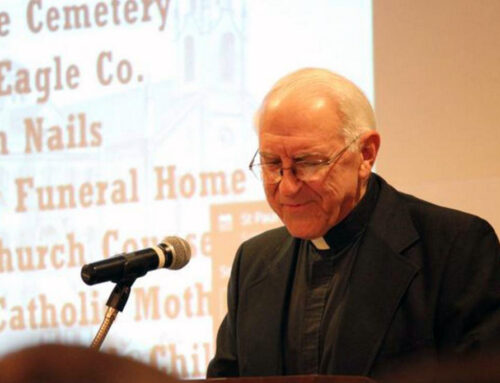On Wednesday morning, June 25, 1884, the Latin word “In limine” was placed above the stage at Reading’s Grand Opera House. It translates to “On the Threshold,” and it was the slogan of Reading High School’s newest graduating class.
Commencement had never been held in the Opera House. Hundreds were turned away. Inside the full theater, audience members waved paper fans.
Prof. Scheibner requested excellent order as he began the exercises. Roy. Dr. Orrick led the class in a prayer before singing the welcome hymn. This was followed by Miss Mary A. Yerger’s salutatory, in which she presented her subject in an engaging manner and immediately garnered her audience’s approval.
On stage in front of them was William Lee Terry, the class valedictorian and the school’s first black graduate. He showed himself to be an exceptionally bright and attentive scholar.
Terry delivered a speech at commencement titled “The End Not Yet.” He was loose in his movements, spoke with great emotion, and spoke loudly enough to be heard across the Opera House. He demonstrated how this life was a grand panoramic view of humanity and its frailties; how it was followed by death, and after that immortal life – teaching that the end is not yet. According to a media source, the speech was “undoubtedly the triumph of the day,” and the applause at the end was deafening.
The Terry family became prominent members of the Reading community after the head of the family Jenny first arrived in the city with her nine children: Moses J., Johnson L., Charles L., Lee B., Frank, Andrew, Helen, Barbara, and Mary. Jenny had been a slave in King George County, VA until her slaveowner, St. Leger Landon Carter, freed her and her children in his will. She and her nine children were taught to read and write and were freed in 1852. William Lee Terry, son of Charles L. Terry and Martha Jane Ginn was born on April 14, 1866.
William Lee Terry continued his studies at Lehigh University in Bethlehem, Pennsylvania, hoping to become the family’s first lawyer. William boarded with an aunt throughout his time in Bethlehem. In January 1885, he scored the highest among all freshman on Lehigh’s winter examinations. The freshmen class included William and 115 white kids.
William became ill in March 1885, while still in college. He left school and went back to Reading. His parents, Charles and Martha, believed he had a terrible cold. Resting did not help. On April 16, Emancipation Day, he died. He was nineteen.
A Reading physician, Dr. Henry Landis made the following statement of the disease: ‘’It was a case of pelvic cellulitis, which is an inflammation of the cellular tissue of the pelvis or lower cavity of the abdomen. This inflammation went on to suppuration or abscess and the abscess broke into the bladder. Subsequent to the breaking of the abscess a general peritonitis and pyemia (blood poisoning) took place, which was the immediate cause of his death. At times, during the course of the disease, he suffered considerable pain, but was generally cheerful and very hopeful up to 5 or 6 days ago, when he became delirious and finally unconscious. I was first called to see him March 20th. The disease was not inflammation of the bladder as stated. The original cause of the disease is not positively known, but may have resulted from over-exertion in gymnastic exercises or taking cold after being heated from such exercises.”
The funeral of the late William Lee Terry took place April 20, 1885 from the residence of his parents, 436 North Tenth street. His remains rested in a handsome walnut casket, silver mounted, the lid bearing a plate with the words “Rest in Peace” His body was dressed in a white satin. On his breast lay a cluster of calla lilies, representing the members of the family, with one flower broken and drooping, over which were the words “Our Star.”
Friends from both Lehigh and Reading High served as pallbearers. At Charles Evans Cemetery, Terry was buried in front of his grandmother Jenny.
William’s aunt attended the burial and was shocked to learn that the parents were unaware of the full history of the case.
William had returned home from campus on January 20th, battered but triumphant, according to her aunt.
He explained that his classmates had tied a long rope around his waist. Two parties then grabbed the ends of the rope and pulled as hard as they could in opposite directions.
The objective was to see how much grit a youngster had; if he yelled, he was regarded as lacking pluck. With the rope wrapped around his waist, he had to hold himself with his feet while a crowd of young men pulled. Terry passed the test, since when he arrived home, his aunt said, he triumphantly remarked to her, in describing the day’s sport “Aunty, they pulled awfully hard, but they couldn’t make me scream.” From that day, the aunt told his parents, his health began to deteriorate.
Harry Koller, a student of the University, was asked what he knew of the case. He replied substantially as follows: “This is the first I have heard of this. There has been no hazing at the University for some time and I am positive Mr. Teny was not injured in that way. The students had the utmost respect for the young man and he was treated very courteously. If he was injured at all during athletic exercises and by having a rope around his waist it must have been in “tug of war” in the gymnasium and directly under the eye of a part of the faculty. Mr. Terry was not injured in any initiatory proceedings or hazing. This was positively done away with some time ago by resolution of the classes, and he must have been misunderstood by those out of the school with whom he spoke after he was through exercising. This should be stated in simple justice to the faculty who will be much grieved to hear of the reports now prevailing.”
A close friend of the Terry family provided a different testimony, verifying the aunt’s version of the situation, stating: “Shortly before Will died, he revealed how he was hurt. One of the exercises in the gymnasium was to train men for the ‘Tug-of-War’ team. Ropes with slipknots were tied around the waist of each man and one pulled at the rope of the other. Perhaps half a dozen may have taken hold. It was necessary to brace strongly with the lower limbs.
The practices now recognized as hazing have existed for over 2,000 years. Throughout history, educators have had to deal with physical abuse, practical jokes, excessive alcohol consumption, and other embarrassing and dangerous occurrences that have become rites of passage for many young adults. By the 1880s, hazing had become regular practice. Tough tug-of-war matches between the freshman and sophomore classes were usual. As is true now, hazings were concealed or portrayed in the best possible way.
Following Terry’s funeral, there appears to have been little coverage of his death. According to a letter published in the Lehigh Alumni Bulletin during the 1933-1934 academic year, Terry, a “very fine colored fellow,” was the anchor of his class tug-of-war team. The alumnus criticized reporters for reporting that Terry died as a result of injuries caused by classmates. “Denials were made by the university, but it was a long time before the people were convinced of the true story,” the alumnus wrote.





Leave A Comment